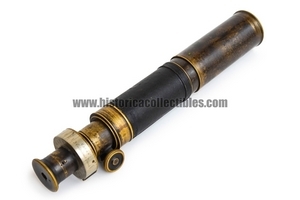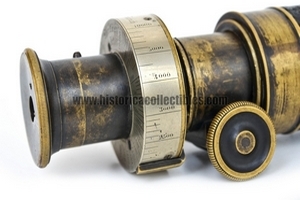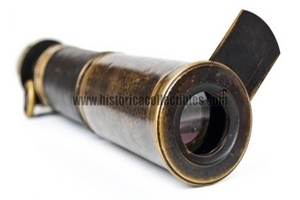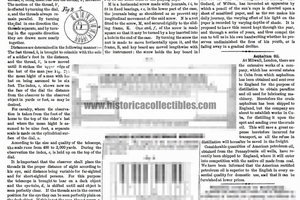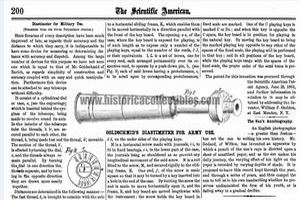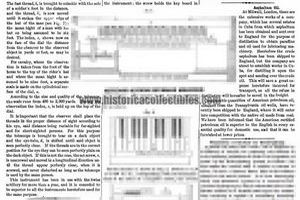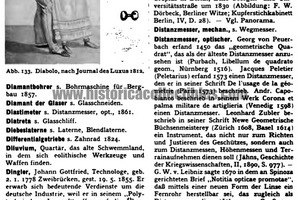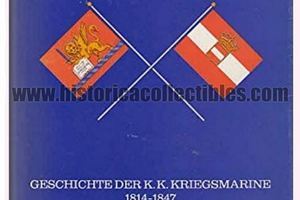Diastimeter, J. Goldschmid, Zürich, Österreichische-Venezianische Kriegsmarine, 1840
This is the first telescope in the world equipped with a rangefinder, at the time called "Diastimeter" or "Distanzmesser" (Distancemeter), built by Jakob Goldschmid in Zürich in about 1840, for the Artillery of the Österreichische-Venezianische Kriegsmarine.
The telescope, made in five sections (or stages), completely in brass, extends for a total length of 78 cm open and 34 cm closed. It is equipped with a mechanical guillotine telemetry system, integrated in the eyepiece tube, which allows to detect the distance between the observation point and the target framed in the objective.
During observation, by rotating the telemetric mechanism, two opposing metal "eyelids" can be seen inside, which when closing (or opening) form an ellipse. It follows that, the more precisely the shape of the target is placed inside the profile of the ellipse, the greater the precision detected by the mechanism suitable for detecting the distance will be; this will consequently allow artillery fire to be carried out, obtaining the best results even on targets placed at great distances.
The unit of measure used on this meter to measure distance is the "Schritt" or "Step".
The maximum distance that could be detected was 10,000 Schritten, while the minimum was 300.
Just above the name of the producer J. Goldschmid Zürich, we find the wording "Cav a '9'.
The attribution of the telescope to the Österreichische-Venezianische Kriegsmarine is established by defining the precise historical period and following a logic. While the latter had a well-established military naval flotilla, the Königlich Preußische Marine, it never achieved such sea power, as it essentially concentrated its strength on the land army.
Finally, the German Confederation had practically no fleet, but only used the allied outposts of Great Britain, the Netherlands and Denmark. Therefore I believe that the study and implementation of this instrument should follow the dictates and requests of an extremely advanced, strong and consolidated Navy, just like the Österreichische-Venezianische Kriegsmarine was.
It is the oldest known scope with this telemetry detection system. Making observations, its very sharp lenses still give us bright and well-defined images. All mechanisms work very smoothly and correctly.
This is to date the only one known.
Learn more about: https://www.goldschmid-aneroide.com/firmengeschich...
Jakob Goldschmid (1815-1876) from Winterthur began his mechanic apprenticeship at Oeri in Zurich in 1832. After his apprenticeship he visited Germany and Austria from 1835-38 and married the daughter of his teacher, Jeanette Oeri, in 1839. The couple had 3 children, 2 daughters and a son, Jakob Caspar Albert.
In 1852 Jakob Goldschmid took over his father-in-law's business in Neustadt, Trittligasse 34. According to J. Höltschl, around 1857 he developed his first "Goldschmid aneroid", named after him. However, this instrument, a barometer altimeter with optical reading, only really caught on at the end of the 1960s.
In the years 1872-73 the company went to one of the sons-in-law, named Rudolf Hottinger-Goldschmid (1834-1883) and was then renamed "Hottinger-Goldschmid & Cie.", meteorological, physical and mechanical workshop. She then describes herself in a prospectus as "J. Goldschmid's successor". R. Hottinger-Goldschmid and Dr. Carl Koppe.
Jakob Goldchmid died in Zurich on May 17, 1876.
Hottinger & Cie was shown at various international exhibitions, for example in Vienna in 1873, in Paris in 1878 and in Graz in 1880. Later, however, another change of ownership seems to have taken place, because a company "Th. Usteri-Reinacher" appears in connection with the "Goldschmid-Aneroids", which describes itself as the successor to Hottinger & Cie.. We are therefore continuing our research .
The son, Jakob Caspar Albert Goldschmid (1843-1918), had the professional title of optician and mechanic, lived in the family house at Trittligasse 34 until 1876, but had his workshop and storeroom at Sonnenqai 2/ Rämistr. 2. He married in 1876 and subsequently left home, but kept his business at Sonnenquai 2. There he traded as "Atelier and Magazine for Mathematical, Optical and Physical Instruments. Aneroids for height measurement, leveling and as a barometer". He later moved to Neuenhofstrasse 14 and traded there as "A. Goldschmid, Sohn". Finally, the next generation, his son Eugen Jonas Goldschmid, continued his father's tradition.
Finally, it remains to be mentioned that Rudolf Hottinger-Goldschmid and Albert Goldschmid are documented in the register of members of the "Schachgesellschaft Zurich", which is by the way the oldest chess association in the world. The preparations of this club for the 200th anniversary in 2009 were also the trigger for Mr. Richard Forster's research. We have him to thank for this comprehensive biography. A heartfelt thank you therefore goes to Zurich.
Born under the name of österreichische Kriegsmarine ("Austrian War Navy", as opposed to the österreichische Handelsmarine which was the merchant navy), it was renamed "Österreichische-Venezianische Kriegsmarine" (Austro-Venetian War Navy), in 1797, following the Treaty of Campoformio, to then return to the original name in 1849 and finally assume that of K.u.K. Kriegsmarine in 1867 as a result of the Ausgleich between the Empire of Austria and the Kingdom of Hungary; in the latter it was known as császári és királyi haditengerészet. At the outbreak of the First World War the Austro-Hungarian navy was sixth in the world in order of size, but with the defeat of the Central Powers and the dissolution of the Empire it was ceded to the newly established State of the Slovenes, Croats and Serbs and then divided among the allies of the Entente. The main ports of the K.u.K. Kriegsmarine were Trieste and Pula on the Adriatic and Linz and Klosterneuburg on the Danube.
The Königlich Preußische Marine was the navy of the Kingdom of Prussia, active from 1701 to 1867, when it was absorbed into the Norddeutsche Bundesmarine. The Prussian navy continued without major interruption until the founding of the North German Confederation in 1867, when the Prussian navy was absorbed into the Norddeutsche Bundesmarine (Northern Federal German Navy).
Over the centuries, Prussia's military power was essentially concentrated on the land army and never achieved such power even on the seas. Despite this, however, Prussia always maintained naval forces, even when it was only the Margraviate of Brandenburg.
The German Confederation had practically no fleet, but used only the allied outposts of Great Britain, the Netherlands and Denmark. During the First Schleswig War of 1848–1851, the failure of this strategy became clear as Britain and the Netherlands remained neutral and Denmark declared itself Germany's enemy. Within days, the Danish Navy halted all trade by Prussian shipping in the Baltic and Northern Seas. The K.u.K. Prussia's ally Kriegsmarine was stationed in the Mediterranean and was unable to intervene in the war until very late. The German Confederation (German: Deutscher Bund) was a loose association of German states formed by the Congress of Vienna in 1815. The Confederation had exactly the same borders as the Holy Roman Empire after the Peace of Westphalia with the exception of Flanders, but contrary to the previous structure member states were fully sovereign. The Confederation collapsed when Prussia and Austria went to war in 1866. All constituent states became part of the German Empire in 1871, except the Austrian Empire, Liechtenstein, Luxembourg and Limburg.

